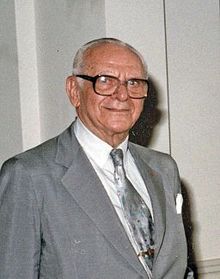Armand Hammer
Armand Hammer (born May 21, 1898 in New York City , † December 10, 1990 in Los Angeles ) was an American industrialist, art collector and doctor. He was the long-time CEO of the US oil company Occidental Petroleum . He was also known as an art collector and through his good relations with the Soviet Union .
Life
Hammer was born in Manhattan to parents of Jewish descent. His father was a doctor, a staunch socialist and emigrated from Odessa . Hammer interpreted his name in his autobiography as "Arm and Hammer", an ancient symbol of the labor movement, a muscular arm that clasps around a hammer. This was the symbol of the Socialist Labor Party of America , the oldest Marxist party in America , of which Hammer's father was an active member.
Following his father's example, Hammer began studying medicine at Columbia University , which he successfully completed in 1921. Shortly after completing his studies, he went to the young Soviet Union on the advice of his father to work as a doctor there, but also to claim outstanding funds for drugs that were delivered. Very soon he began doing business with the USSR , in addition to building up humanitarian aid supplies, especially medicines . Negotiating personally with Lenin , he made his first deal - deliveries of wheat for furs and caviar . In the 1920s, Hammer also stayed in the USSR for long periods of time to control his business. His Moscow apartment became the US unofficial embassy.
Hammer always maintained his solidarity with the Soviet Union and its leaders even during the Cold War ; conversely, Lenin's friend and bearer of the Lenin Order was always welcomed in Moscow. Hammer put his profits from trading in Russia into the oil business until he finally became CEO of Occidental Petroleum in 1957 , a position he did not give up until the 1980s. During this time, the disaster on the Piper Alpha occurred , for which he is attributed a moral complicity. After the Chernobyl disaster on April 26, 1986, he acted as a political mediator between Washington and Moscow in the organization of bone marrow transplants carried out in the spring of 1986 by a team of Californian experts for the patients affected by radiation sickness .
Hammer also became known as an art dealer and collector . He also laid the foundation for this in the Soviet Union. In the end, Hammer acquired no fewer than 13 Fabergé eggs and other art treasures from the Hermitage in Leningrad . He brought his art collection to the Armand Hammer Museum of Art in Los Angeles, which opened shortly before his death . In 1971 he acquired the art trading company M Knoedler & Co .
Hammer had become a legend through his success as a capitalist with simultaneous socialist leanings and excellent relations with communist leaders. Gale, who was the first to travel to Moscow in 1986 to prepare bone marrow transplants for radiation victims in Chernobyl, described Hammer in 1988 as an "often ruthless" businessman who entered his power. It was often suspected that he was an agent and spy, but there was never any evidence in this regard. Because of his Jewish ancestry, he was also attacked by anti-Semites as part of the alleged Jewish world conspiracy .
His great-grandson is the actor Armie Hammer .
Trivia
Armand Hammer was asked so often about a possible connection between his name and the baking powder brand "Arm & Hammer" (pronounced: Arm änd Hämmer) that he tried to buy the brand owner Church & Dwight and became a major shareholder of the company.
literature
- Waltraud Bayer (ed.): Sold culture. The Soviet art and antiques exports, 1919-1938. Peter Lang Verlag, Frankfurt am Main 2001, ISBN 3-631-38380-0 .
Web links
- Literature by and about Armand Hammer in the catalog of the German National Library
Individual evidence
- ↑ http://emile.uni-graz.at/pub/04S/2004-07-0016.doc ( page no longer available , search in web archives ) Info: The link was automatically marked as defective. Please check the link according to the instructions and then remove this notice. (accessed October 4, 2007)
- ↑ DLF calendar sheet of July 6, 2013: 25 years of the "Piper-Alpha" accident, the most serious accident to date on an oil platform
- ↑ Axel W. Bauer , Anthony D. Ho: Chernobyl 1986 - Disaster relief as a means of relaxation policy. How bone marrow transplants by American hematologists contributed to the rapprochement between East and West. In: Medical historical messages. Journal for the history of science and specialist prose research. Volume 34, 2015 (2016), pp. 195–209, here: pp. 196–200.
- ↑ Kulturweltspiegel on the Russian art trade after the October Revolution ( Memento from March 6, 2004 in the Internet Archive )
- ↑ See also the US journalist Steve Sailer: The Bolshevik Billionaire . In: Taki's Magazine. from July 15, 2015.
- ↑ Robert Peter Gale: Chernobyl - the last warning. The medicine after the reactor disaster (I). In: Der Spiegel. No. 16, 1988 of April 18, 1988, pp. 146-159, here: p. 152.
| personal data | |
|---|---|
| SURNAME | Hammer, Armand |
| BRIEF DESCRIPTION | American industrialist and art collector |
| DATE OF BIRTH | May 21, 1898 |
| PLACE OF BIRTH | Manhattan |
| DATE OF DEATH | December 10, 1990 |
| Place of death | los Angeles |
